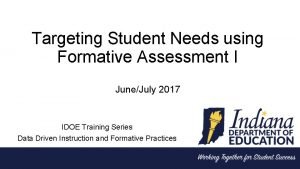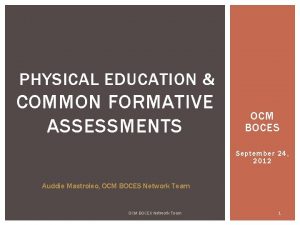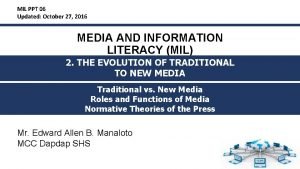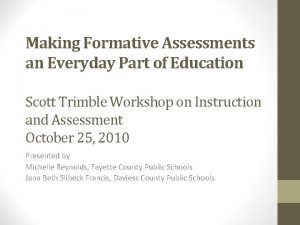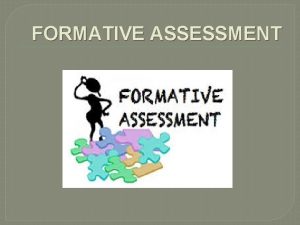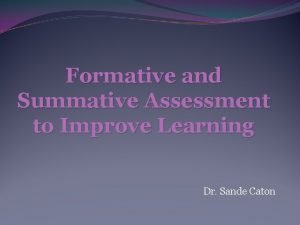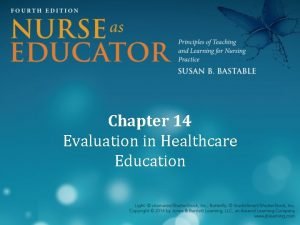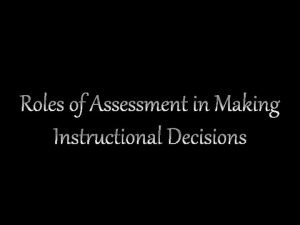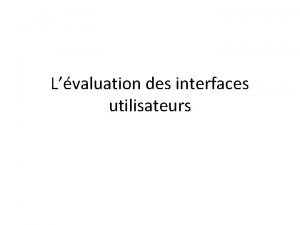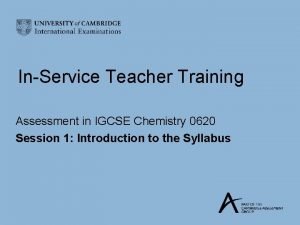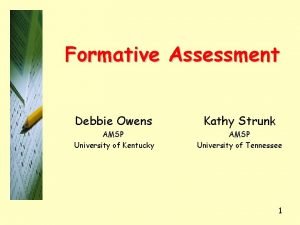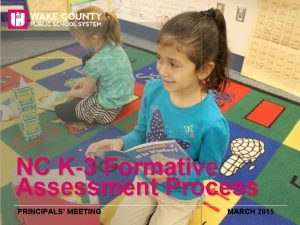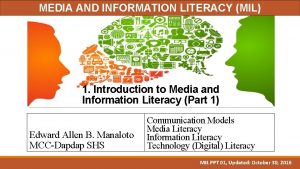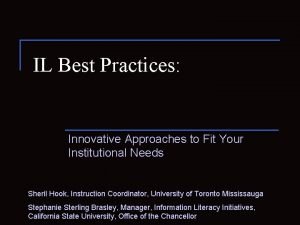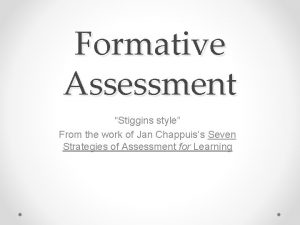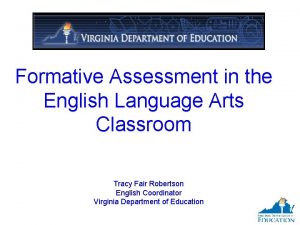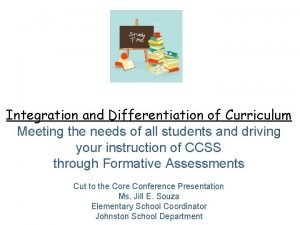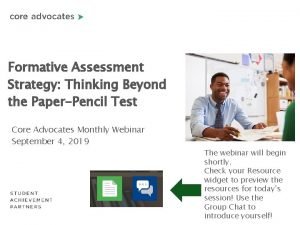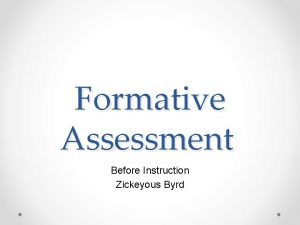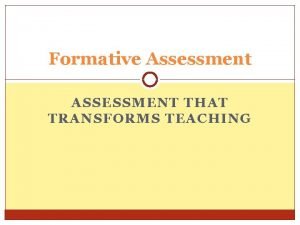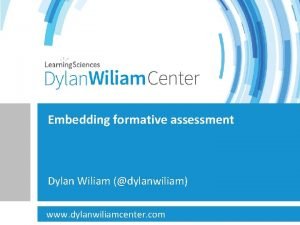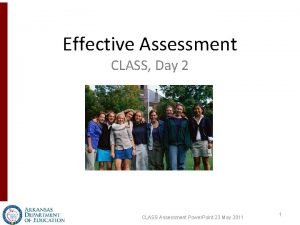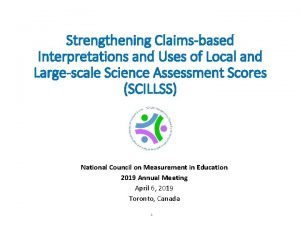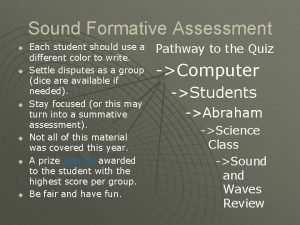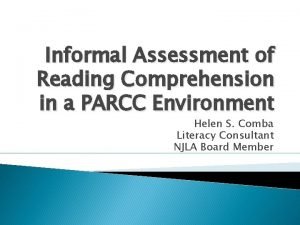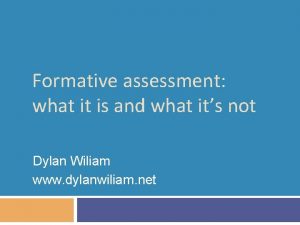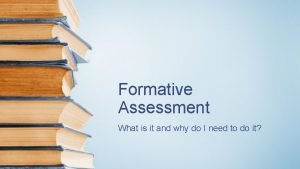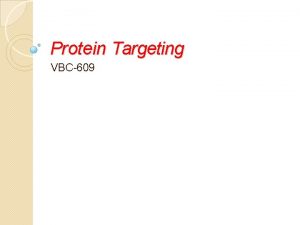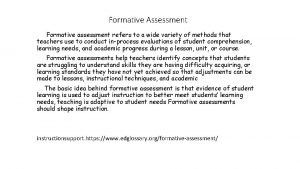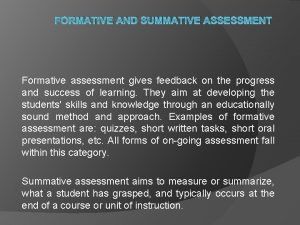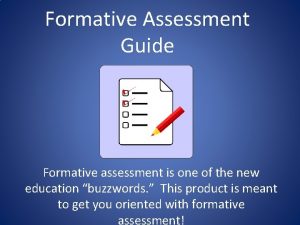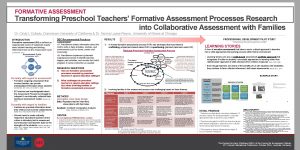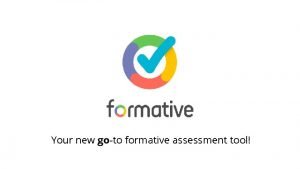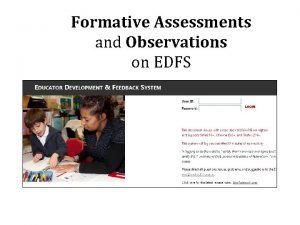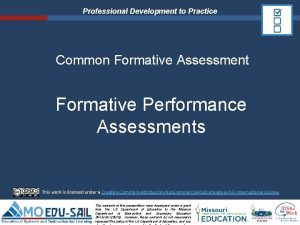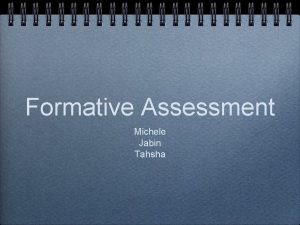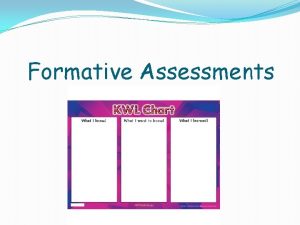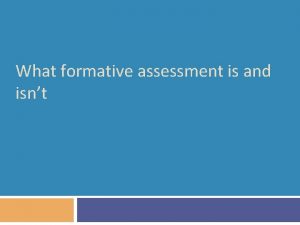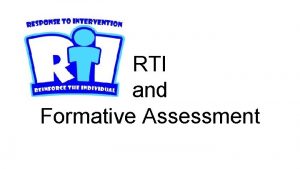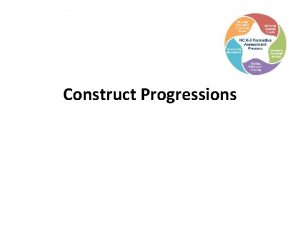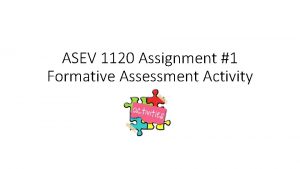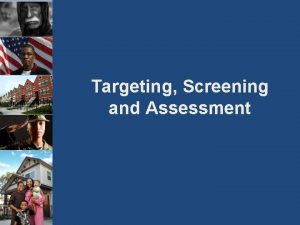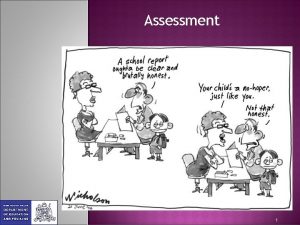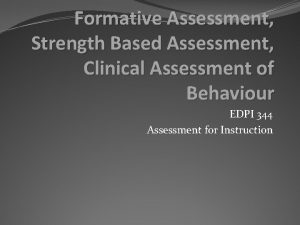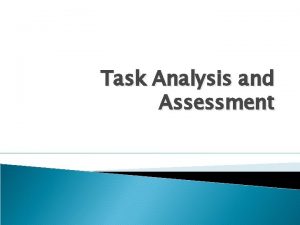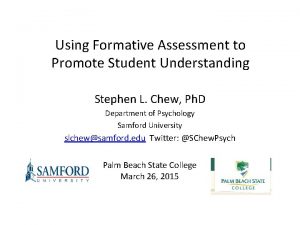Targeting Student Needs using Formative Assessment I JuneJuly































- Slides: 31

Targeting Student Needs using Formative Assessment I June/July 2017 IDOE Training Series Data Driven Instruction and Formative Practices

Welcome

Agenda • Assessments • Understanding the Purpose • Assessment Spectrum • Summative • Benchmark / Interim • Formative • Benefits of Formative Assessment • Formative Assessment Process • Keys to Effective Formative Assessment • Formative Assessment In Practice • Invitation • References

Review of Assessments

Assessment A process of collecting evidence to make informed decisions.

Assessment “Assessment is crucial to move from opinions to informed action” (National Research Council, 2001). • Educators, students, families, community members, and policy makers use assessment evidence to make informed decisions about student learning, curriculum, instruction, resources, professional development, accountability, and policies. • No single assessment measure, tool, or practice can provide the information needed to make all these decisions. So, we use a balanced system with a variety of assessments that work together.

Understanding the Purpose Determine what evidence is required and strategically select the type of assessment that will provide that information. Chappuis, et al (2012) There are 3 questions we need to ask to decide what assessment to use: 1. Who is going to use the information? 2. How will they use it? 3. What information, in what detail, do they need?

Assessment Spectrum

Assessment Spectrum (continued) Assessments can be used summatively or formatively. • Assessments used summatively provide information after instruction and learning o Large-scale statewide tests o End of unit classroom tests o Final project • Assessments used formatively provide information during instruction and learning. o Learning journals o Observations of small group discussions o Rubrics

Summative Assessments • Renders a judgment after the conclusion of instruction and learning, and, as the spectrum showsed, can occur at the system or classroom level. • Assessment of learning (Chappuis, et al, 2012) Large-scale, standardized summative assessments are designed to: • Broadly measure student achievement • Support evaluative judgments on the overall impact and effectiveness of educational programs at the end of the course, the study or the end of the school year.

Benchmark / Interim Assessments Can be used summatively OR formatively. • Summatively they: • Measure students achievement several times a year. • Determine students progress towards grade-level standards. • Hold educational programs accountable • Signal areas for investigating curriculum scope, sequence, and planning professional development. • Formatively they: • Provide baseline (pre-assessment) data about where students are along the learning progression before instruction begins. • Provide data that informs lesson plans and decisions about small group composition.

Benchmark / Interim Assessments (continued) Note: Indiana’s use of the Formative Assessment Grant has primarily focused on the formative use of benchmark/interim assessments. Our vision is to expand opportunities to include a broader range of assessment practices that support student growth. These trainings and future professional development opportunities are designed to help broaden educators’ understanding of formative assessment and their use of different formative assessment strategies in the classroom.

Formative Assessment is… …the planned, continuous process teachers and students use to reveal learning, analyze learning, and adjust instruction and learning strategies to enhance students’ achievement of intended outcomes.

Formative Assessment • A purposeful process that requires planning and preparation before instruction and learning begin. Focus on thoughtful planning and reflection: Sometimes strategies that could be formative are employed, but no formative outcomes are produced because of a lack of thoughtfulness regarding the data collected. • Uses multiple sources of information to determine how students are progressing toward the intended learning goals. • Evidence helps teachers adjust instruction and helps students adjust their learning strategies to enhance achievement. • Classroom-based • Supports learning while learning occurs (Linquanti, 2014) • Assessment for learning (Chappuis, et al, 2012) • Real-time use of evidence by teachers and students to propel progress forward

Formative Assessment is not… • An Event • Focused on a Single Piece of Information • A Bank of Test Items • Graded

Formative Assessment

Benefits of Formative Assessment

Benefits of Formative Assessment Increased Learning Gains Especially for Low Achieving Students Raises Overall Achievement Development of Interpersonal and Intrapersonal Skills Increased Feelings of Confidence and Control Increases Student Motivation Encourages Growth Mindset Increased Time on Task Develops Deeper Learning

Formative Assessment Process

Learning Progression Guided by Formative Assessment Content based on Iowa Department of Education

Formative Assessment Process § Clarify the Learning v Determine learning goals and criteria for success for the lesson/unit/etc. v Identify outcomes and measures of success v Answers the question “Where am I going? ” § Elicit Evidence of Learning v Examples include: • • • Pre-assessment Rich learning tasks* Exit tickets Individual white boards Ungraded quizzes v Peer and self-assessment* • • • Concept maps Graphic organizers Interview Presentations Focused questions* • • Journals Learning logs Fishbowl Observations * = more on this in the next webinar

Formative Assessment Process (continued) § Interpret Evidence* v Answers the question “Where am I now? ” v Not a single event • Interpreted in the formative assessment process on an ongoing basis throughout instruction. § Respond to Evidence v Use actionable feedback to plan how to move learning forward v Answers the questions “Where to next? ” and “How do I get there? ” § Close the Gap v Eliciting, interpreting, and responding to evidence, teachers and students maximize opportunities for students to successfully achieve the learning outcomes v As one gap closes, teachers, and students create new learning goals renewing the formative assessment process. * = more on this in the next webinar

Keys to Effective Formative Assessment

Keys to Strong Formative Assessment ü Identify and communicate clearning goals and success criteria. Ensure students understand where they are going. ü Plan for and elicit evidence of learning during instruction. ü Interpret the evidence to identify where students are in relation to the learning goals and success criteria. ü Use feedback to make adjustments to instructional strategies and learning approaches to move students learning forward. ü Involve students throughout the formative assessment process. In particular, support students to engage in peer- and self-assessment and self-reflection to develop metacognition and self-regulation. ü Foster a collaborative classroom culture where students and teachers are partners in learning.

Formative Assessment in Practice

What does formative assessment look like in practice? As you watch the following videos, look for: How data is collected. How data is analyzed. How data is used to adjust instructional practices. Note: Media files have been removed from this version of the presentation.

Invitation to: Incorporate Formative Assessment Practices

Invitation to Incorporate into Daily Practice • Incorporate into Class Practice in 2017 -2018 • IDOE Training Series Data Driven Instruction and Formative Practices Wednesday, August 30 th 10: 00 a. m. EDT Tuesday, September 12 th 2: 00 p. m. EDT Thursday, September 14 th 10: 00 a. m. EDT • Rubric to Measure Effectiveness of Strategies* Mary Williams (317)-234 -5602 | (317) 232 -9050 mwilliams@doe. in. gov

References • Black, P. & Wiliam, D. (1998 a). Assessment and classroom learning. Assessment in Education, March 1998, 7 -74. • Black, P. , & Wiliam, D. (1998 b). Inside the black box: Raising standards through classroom assessment. Phi Delta Kappan, October 1998, 139 -148. • Bloom, B. (1984). The search for methods of group instruction as effective as one-to-one tutoring. Educational Leadership, 41(8), 4– 17. • Brookhart, S. , Moss, C. , & Long, B. (2008). Formative assessment that empowers. Educational Leadership, 66(3), 52 -57. • Cauley, K. M. & Mc. Milan, J. H. (2010). Formative assessment techniques to support student motivation and achievement. Clearing House: A Journal of Educational Strategies, Issues, and Ideas, 83(1), 1 -6. • Chappuis, J. , Stiggins, R, Chappuis, S. , & Arter, J. (2012). Classroom assessment for student learning: Doing it right – using it well. 2 nd edition. Upper Saddle River, NJ: Pearson. • Clinchot, M. , Ngai, C. , Huie, R, Talanquer, V. , Lambertz, J. , Banks, G. , Weinrich, M. , Lewis, R. , Pelletier, P. , & Sevian, H. (2017). Better formative assessment: Making formative assessment more responsive to student needs. The Science Teacher, 84(3), 69 -75. • Fisher, D. & Frey, N. (2007). Checking for understanding: Formative assessment techniques for your classroom, Alexandria, VA: Association for Supervision and Curriculum Development. • Gong, B. (2012). Using balanced assessment systems to improve student learning and school capacity: An introduction. Council of Chief State School Officers and Renaissance Learning. http: //www. ccsso. org/Documents/Balanced%20 Assessment%20 Systems%20 GONG. pdf • Hanover (2014). The impact of formative assessment and learning intentions on student achievement. Washington, DC: Hanover Research. • Herman, J. L. , & Heritage, M. (2007). Moving from piecemeal to effective formative assessment practice: Moving pictures on the road to student learning. Paper presented at the annual Council of Chief State School Officers (CCSSO) National Conference on Large Scale Assessment, Session 143, Nashville, TN. • Heritage, M. (February, 2014). Formative assessment: An enabler of learning. Presentation to Oakland Schools. www. laco. org/Site. Assets/Site. Pages/New%20 Page/Heritage%20 ppt. pptx

References (continued) • Heritage, M. (June, 2012). Effective formative assessment. Webinar for CORE. https: //relwested. org/system/related_materials/102/Formative_Assessment_Webinar_PPT. Heritage. pdf? 1339783522 • Heritage, M. (2010). Formative assessment: Making it happen in the classroom. Thousand Oaks, CA: Corwin Press. • Iowa Department of Education. (2017). Assessment FOR learning (formative assessment). https: //www. educateiowa. gov/pk-12/studentassessment/assessment-learning-formative-assessment • Linquanti, R. (2014). Supporting formative assessment for deeper learning: A primer for policymakers. Washington, D. C. : CCSSO • Marzano, R. (2006). Classroom assessment and grading that work. Alexandria, VA: Association for Supervision and Curriculum Development. • National Council of Teachers of English. (2010). Fostering high-quality formative assessment. https: //secure. ncte. org/library/NCTEFiles/Resources/Policy. Research/CC 0201 Policy. Brief. pdf • National Research Council (2001). Knowing what students know. Washington, D. C. : NRC. • Nicol, D. & Macfarlane‐Dick, D. (2006). Formative assessment and self‐regulated learning: A model and seven principles of good feedback practice. Studies in Higher Education, 31(2), 199 -218. • Popham, W. J. (2008). Transformative assessment. Alexandria, VA: Association for Supervision and Curriculum Development. • Sadler, D. R. (1989). Formative assessment and the design of instructional systems. Instructional Science, 18, 119 -44. • Viering, M. (2016). An argument formative assessment: Motivation and persistence. • http: //www. pearsoned. com/education-blog/formative-assessment-motivation-persistence/

Thank you!
 Formative assessment process
Formative assessment process Formative assessments in physical education
Formative assessments in physical education Mil ppt
Mil ppt Basic components of media and information literacy
Basic components of media and information literacy Citizen journalism
Citizen journalism Scott trimble workshop
Scott trimble workshop Summative and formative assessment
Summative and formative assessment Formative and summative assessment
Formative and summative assessment Facets of formative assessment
Facets of formative assessment Difference between formative and summative assessment
Difference between formative and summative assessment Placement formative diagnostic and summative assessment
Placement formative diagnostic and summative assessment Formative vs summative usability testing
Formative vs summative usability testing Nature of formative assessment
Nature of formative assessment Round robin charts formative assessment
Round robin charts formative assessment Common core institute
Common core institute Formative assessment
Formative assessment Ritual or expressive model of communication
Ritual or expressive model of communication Formative assessment is tasting the soup while cooking
Formative assessment is tasting the soup while cooking Formative style
Formative style Formative assessment
Formative assessment Examples of formative assessment
Examples of formative assessment Examples of formative assessment
Examples of formative assessment Formative assessment examples
Formative assessment examples Summative and formative assessment
Summative and formative assessment Dylan williams formative assessment
Dylan williams formative assessment Examples of formative assessment
Examples of formative assessment Advantage of criterion-referenced assessment
Advantage of criterion-referenced assessment Diagnostic assessment examples
Diagnostic assessment examples Formative assessment
Formative assessment Example of formative assessment
Example of formative assessment Formative assessment
Formative assessment Formative assessment
Formative assessment
